EWS/FLI mediated reprogramming of 3D chromatin promotes an altered transcriptional state in Ewing sarcoma
- PMID: 36124657
- PMCID: PMC9508825
- DOI: 10.1093/nar/gkac747
EWS/FLI mediated reprogramming of 3D chromatin promotes an altered transcriptional state in Ewing sarcoma
Abstract
Ewing sarcoma is a prototypical fusion transcription factor-associated pediatric cancer that expresses EWS/FLI or a highly related FET/ETS chimera. EWS/FLI dysregulates transcription to induce and maintain sarcomagenesis, but the mechanisms utilized are not fully understood. We therefore sought to define the global effects of EWS/FLI on chromatin conformation and transcription in Ewing sarcoma cells using a well-validated 'knock-down/rescue' model of EWS/FLI function in combination with next generation sequencing assays to evaluate how the chromatin landscape changes with loss, and recovery, of EWS/FLI expression. We found that EWS/FLI (and EWS/ERG) genomic localization is largely conserved across multiple patient-derived Ewing sarcoma cell lines. This EWS/FLI binding signature is associated with establishment of topologically-associated domain (TAD) boundaries, compartment activation, enhancer-promoter looping that involve both intra- and inter-TAD interactions, and gene activation. In addition, EWS/FLI co-localizes with the loop-extrusion factor cohesin to promote chromatin loops and TAD boundaries. Importantly, local chromatin features provide the basis for transcriptional heterogeneity in regulation of direct EWS/FLI target genes across different Ewing sarcoma cell lines. These data demonstrate a key role of EWS/FLI in mediating genome-wide changes in chromatin configuration and support the notion that fusion transcription factors serve as master regulators of three-dimensional reprogramming of chromatin.
© The Author(s) 2022. Published by Oxford University Press on behalf of Nucleic Acids Research.
Figures


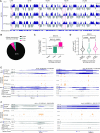
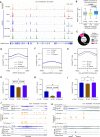
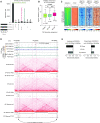
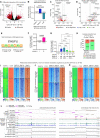

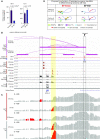
Similar articles
-
Tumor-specific retargeting of an oncogenic transcription factor chimera results in dysregulation of chromatin and transcription.Genome Res. 2012 Feb;22(2):259-70. doi: 10.1101/gr.125666.111. Epub 2011 Nov 15. Genome Res. 2012. PMID: 22086061 Free PMC article.
-
The FLI portion of EWS/FLI contributes a transcriptional regulatory function that is distinct and separable from its DNA-binding function in Ewing sarcoma.Oncogene. 2021 Jul;40(29):4759-4769. doi: 10.1038/s41388-021-01876-5. Epub 2021 Jun 18. Oncogene. 2021. PMID: 34145397 Free PMC article.
-
Mechanism and relevance of EWS/FLI-mediated transcriptional repression in Ewing sarcoma.Oncogene. 2013 Oct 17;32(42):5089-100. doi: 10.1038/onc.2012.525. Epub 2012 Nov 26. Oncogene. 2013. PMID: 23178492 Free PMC article.
-
Therapeutic opportunities in Ewing sarcoma: EWS-FLI inhibition via LSD1 targeting.Oncotarget. 2016 Apr 5;7(14):17616-30. doi: 10.18632/oncotarget.7124. Oncotarget. 2016. PMID: 26848860 Free PMC article. Review.
-
Molecular pathogenesis of Ewing sarcoma: new therapeutic and transcriptional targets.Annu Rev Pathol. 2012;7:145-59. doi: 10.1146/annurev-pathol-011110-130237. Epub 2011 Sep 19. Annu Rev Pathol. 2012. PMID: 21942527 Free PMC article. Review.
Cited by
-
Extensive long-range polycomb interactions and weak compartmentalization are hallmarks of human neuronal 3D genome.Nucleic Acids Res. 2024 Jun 24;52(11):6234-6252. doi: 10.1093/nar/gkae271. Nucleic Acids Res. 2024. PMID: 38647066 Free PMC article.
-
Open-Label, Multicenter, Phase I/II, First-in-Human Trial of TK216: A First-Generation EWS::FLI1 Fusion Protein Antagonist in Ewing Sarcoma.J Clin Oncol. 2024 Nov;42(31):3725-3734. doi: 10.1200/JCO.24.00020. Epub 2024 Jul 2. J Clin Oncol. 2024. PMID: 38954782 Clinical Trial.
-
Ewing Sarcoma Related protein 1 recognizes R-loops by binding DNA forks.bioRxiv [Preprint]. 2024 Jan 21:2024.01.20.576463. doi: 10.1101/2024.01.20.576463. bioRxiv. 2024. Update in: Biopolymers. 2024 May;115(3):e23576. doi: 10.1002/bip.23576. PMID: 38293191 Free PMC article. Updated. Preprint.
-
Preclinical models for the study of pediatric solid tumors: focus on bone sarcomas.Front Oncol. 2024 Jul 18;14:1388484. doi: 10.3389/fonc.2024.1388484. eCollection 2024. Front Oncol. 2024. PMID: 39091911 Free PMC article. Review.
-
Through the lens of phase separation: intrinsically unstructured protein and chromatin looping.Nucleus. 2023 Dec;14(1):2179766. doi: 10.1080/19491034.2023.2179766. Nucleus. 2023. PMID: 36821650 Free PMC article. Review.
References
-
- Seth A., Watson D.K.. ETS transcription factors and their emerging roles in human cancer. Eur. J. Cancer. 2005; 41:2462–2478. - PubMed
Publication types
MeSH terms
Substances
Grants and funding
LinkOut - more resources
Full Text Sources
Molecular Biology Databases

